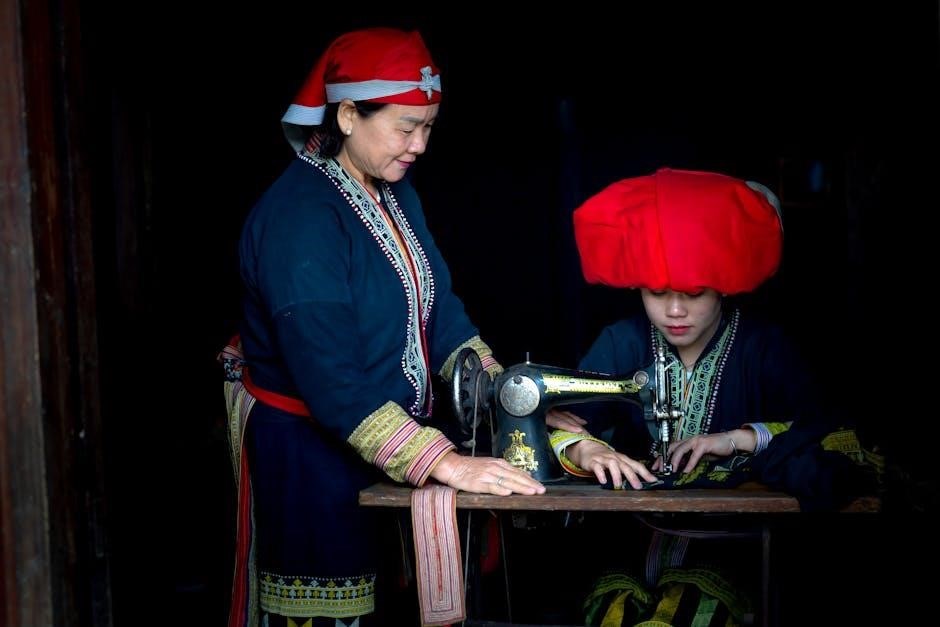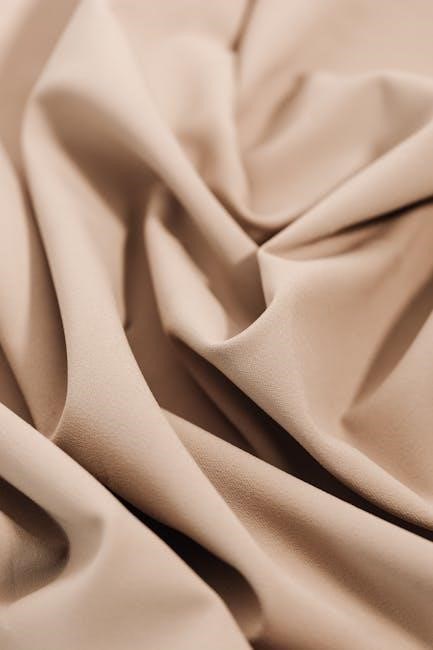Tailoring in World of Warcraft: Cataclysm is a versatile profession that allows players to craft cloth armor, bags, and specialty items. With a skill cap of 525, it offers opportunities for both crafting gear and generating profit through the Auction House. This guide provides a comprehensive overview of the profession, including materials, leveling strategies, and high-demand items for endgame content.
1.1 Overview of Tailoring Profession
Tailoring is a primary profession in World of Warcraft: Cataclysm that enables players to craft cloth armor, bags, and enchantments. With a skill cap of 525, it offers a wide range of crafting opportunities. Tailors can create gear for classes like Priests, Mages, and Warlocks, as well as specialty items for endgame content. New materials like Embersilk Cloth and advanced recipes make Tailoring versatile and rewarding, both for equipping characters and generating profit.
1.2 Importance of Tailoring in Cataclysm
Tailoring is essential for crafting high-demand cloth armor and bags, making it a vital profession for PvE and PvP. It provides gear for Priests, Mages, and Warlocks, enhancing their performance in raids and dungeons. Additionally, Tailors can craft specialty items like enchantments, increasing their character’s versatility. The profession also offers strong profit opportunities through the Auction House, making it a valuable skill for both progression and wealth accumulation in Cataclysm.
Choosing the Right Race and Class
Selecting the right race and class is crucial for maximizing Tailoring benefits. Races like Gnomes and Night Elves offer bonuses, while classes such as Priests and Mages rely heavily on cloth armor, making Tailoring a highly complementary profession for them.
2.1 Race Selection for Tailoring Bonuses
Certain races offer bonuses that enhance Tailoring efficiency. Gnomes gain increased expertise, reducing crafting costs, while Night Elves and Draenei provide beneficial stats. Choosing a race with Tailoring bonuses can significantly improve crafting speed and resource efficiency, making it a strategic decision for players aiming to master the profession quickly and effectively in Cataclysm.
2.2 Class Synergies with Tailoring
Tailoring is most beneficial for cloth-wearing classes like Priests, Mages, and Warlocks, as they rely on crafted gear and bags. Druids and Paladins, while leather-users, can still benefit from bag crafting. Tailors can create armor, bags, and specialty items, making it a versatile profession for classes needing cloth gear or additional inventory space, while also offering profit opportunities through the Auction House.
Materials and Resources
Tailoring requires various cloths, threads, and dyes. Key materials include linen, wool, silk, and embersilk, with coarse thread being essential for crafting. Shopping lists vary by expansion phase, ensuring efficient progression through the skill tree. Proper material management is crucial for crafting success and profitability in Cataclysm Classic.
3.1 Essential Cloth Types
In Cataclysm Classic, tailors rely on specific cloth types to craft items. Linen Cloth is the foundation for early recipes, while Wool Cloth becomes essential for mid-level crafting. Silk Cloth and Mageweave Cloth are used for higher-tier items, with Embersilk Cloth being crucial for endgame recipes. Each cloth type serves a unique purpose, and understanding their roles is key to efficient crafting and progression in the tailoring profession.
3.2 Shopping List by Expansion Phase
A well-organized shopping list is crucial for efficient tailoring progression. For the Vanilla phase, stock up on 220 Linen Cloth and 140 Wool Cloth. During Burning Legion, gather 820 Silk Cloth and 380 Mageweave Cloth; In Cataclysm, focus on 820 Embersilk Cloth. These quantities are estimates, and actual needs may vary based on crafting luck and recipe choices. Purchasing materials in bulk from vendors or the Auction House ensures a smooth progression.
Training and Profession Setup
Setting up your tailoring profession begins with locating trainers in major cities. They teach essential recipes and help you understand the profession mechanics. Properly organizing your UI ensures easy access to recipes and materials, streamlining your crafting process. This setup is crucial for efficient skill progression and mastering the craft.
4.1 Locating and Training with Tailoring Trainers
Tailoring trainers are found in major cities like Stormwind and Orgrimmar. Speak to them to learn the profession and unlock Cataclysm-specific recipes. Ensure you click the Cataclysm filter in your profession window to focus on relevant recipes. This step is essential for advancing your tailoring skills efficiently and crafting items suitable for the expansion’s content.
4.2 Switching to Cataclysm Recipes
To progress effectively, ensure you switch to Cataclysm-specific recipes by clicking the Cataclysm filter in your profession window. This step is crucial for unlocking expansion-specific patterns and materials. Failing to switch may result in crafting outdated items, hindering your progression. Always verify the recipe list corresponds to the Cataclysm expansion to ensure you’re crafting relevant and useful items for the current content.
Leveling Tailoring: 1-75
Begin with Coarse Thread, crafting bolts and basic bags. This phase focuses on essential items, requiring around 59x Coarse Thread. Buy materials from vendors near trainers for efficiency.
5.1 Efficient Use of Coarse Thread
Coarse Thread is crucial for crafting early Tailoring items like bolts and bags. Use SHIFT+CLICK to buy in bulk from vendors, maximizing efficiency. This method ensures you have enough materials to progress smoothly through the 1-75 skill range without frequent resupply trips.
5.2 Recommended Recipes for Early Levels
For early Tailoring levels, focus on crafting Linen Cloth items like Linen Cloak and Woolen Cape. These recipes provide steady skill gains and require minimal materials. Bolt of Linen Cloth is also essential, as it’s used in higher-level recipes. Prioritize these to efficiently progress through the early stages and ensure a smooth transition to more complex patterns.

Leveling Tailoring: 75-150
Transitioning to Wool Cloth, this range focuses on crafting efficient gear like Woolen Cloaks and Robes. These recipes provide steady skill gains and prepare you for higher-level patterns.
6.1 Transitioning to Wool Cloth
At level 75, tailors transition to Wool Cloth, a key material for crafting mid-tier items. This phase requires a steady supply of Wool Cloth and Coarse Thread. Crafting Woolen Cloaks, Robes, and other garments becomes essential for skill progression. This transition marks a shift toward more complex patterns, preparing you for higher-level recipes. Stocking up on materials ensures uninterrupted progress, while Auction House purchases can supplement your supply if needed.
6.2 Optimal Recipes for Skill Gains
For skill gains between 75-150, focus on crafting Woolen Cloaks, Woolen Robes, and Bolt of Woolen Cloth. These recipes provide consistent skill progression and are cost-effective. Woolen Cloaks and Robes are crafted using Wool Cloth and Coarse Thread, while Bolts of Woolen Cloth require multiple Wool Cloths. Prioritize these recipes to maximize efficiency and ensure steady skill increases. Stocking up on Wool Cloth beforehand is crucial to maintain progress without delays.
Leveling Tailoring: 150-225
From 150-225, tailors transition to Silk and Mageweave Cloth, crafting higher-tier items like Silk Cloaks and Mageweave Robes. This phase is crucial for mastering intermediate patterns and preparing for more complex recipes ahead. Focus on using these materials to maintain steady skill progression and unlock advanced crafting opportunities.
7.1 Utilizing Silk and Mageweave Cloth
Silk and Mageweave Cloth become essential materials during the 150-225 skill range. Silk Cloth, often used for lightweight armor, is abundant in zones like Western Plaguelands and Eversong Woods. Mageweave Cloth, known for its durability, is frequently farmed in areas like Searing Gorge. Both materials are crucial for crafting mid-tier items like Silk Cloaks and Mageweave Robes, which are in high demand. Consistent use of these cloths ensures steady skill progression and prepares you for more complex recipes ahead.
7.2 Effective Recipes for This Range
During the 150-225 range, focus on crafting Silk Cloaks and Mageweave Robes for consistent skill gains. These recipes are cost-effective and utilize Silk and Mageweave Cloth efficiently. Additionally, crafting Mageweave Belts provides a quick way to gain skills in bulk. These items are in demand, making them ideal for both progression and profit. Prioritize recipes with high demand to optimize your crafting sessions and resource usage.

Leveling Tailoring: 225-300
Transition to Embersilk Cloth for higher-level crafting. Focus on recipes like Embersilk Cloaks and Spellthreads to efficiently reach skill level 300, balancing progression with resource management.
8.1 Embersilk Cloth and Its Importance
Embersilk Cloth is a key material for high-level tailoring recipes, essential for crafting epic gear and specialty items. It becomes the primary resource from level 225 onward, replacing earlier cloths. Embersilk is crucial for creating top-tier equipment like cloaks and robes, which are in high demand by casters. Efficient use of Embersilk ensures faster progression through the higher skill levels, making it indispensable for mastering Cataclysm Tailoring.
8.2 Best Practices for Efficient Leveling
To level Tailoring efficiently from 225 to 300, focus on bulk material purchases and prioritize high-demand recipes. Use add-ons like Auctionator to monitor market trends and optimize profits. Keep a well-stocked inventory of Embersilk Cloth and crafting materials to minimize downtime. Regularly check your profession window to ensure you’re using the most skill-efficient recipes; Crafting in bulk and selling excess items on the Auction House can help fund further progression and maximize efficiency.
Advanced Tailoring: 300-525
Advanced Tailoring unlocks epic gear and specialty items, enhancing your character’s endgame capabilities. Focus on crafting high-demand items like gear sets and rare materials for profit and progression.
9.1 Crafting Epic Gear and Special Items
Crafting epic gear and special items is a hallmark of advanced Tailoring in Cataclysm. At higher levels, tailors can create powerful cloaks, robes, and unique items like Embersilk and Enchanted fabrics. These items are highly sought after for endgame content and raids, making them valuable for both personal use and sale on the Auction House. Crafting these requires rare materials and precise recipes, ensuring high demand and profitability.
9.2 High-Demand Items for Endgame
In Cataclysm, high-demand items for endgame include bags like the Royal Satchel and Emerald Bag, which offer additional inventory space. Healers and casters covet cloaks and robes with Intellect and Spirit stats, while Enchanting items like Enchanted Cloth are sought after for their utility. These items are essential for raids and dungeons, making them highly profitable when crafted and sold on the Auction House.

Crafting for Profit
Crafting for profit in Cataclysm Tailoring involves creating high-demand items like bags and cloaks. Use Auction House strategies to maximize gold by timing sales and optimizing prices.
10.1 Identifying Profitable Items
Identifying profitable Tailoring items in Cataclysm involves focusing on high-demand goods like Embersilk Bags and Cloaks of Might. These items are sought after by players for inventory expansion and endgame gear. Additionally, crafting Spellthread and Ebonweave materials can yield significant profits. Monitoring the Auction House for trends and undercutting competitors ensures maximum gold earnings. Crafting in bulk and timing sales during peak demand periods further enhances profitability.
10.2 Effective Auction House Strategies
Mastering the Auction House is key to maximizing Tailoring profits. Use add-ons like Auctionator to track market trends and undercut competitors. Post items in bulk during peak hours for higher visibility. Focus on high-demand goods like bags and cloaks. Set competitive prices to ensure quick sales. Timing your listings during raid hours or weekends can significantly boost profitability. Regularly restocking popular items ensures consistent gold income.

Tips and Tricks
Use add-ons like Auctionator to analyze market trends and optimize pricing. Buy materials in bulk during sales or from low-price vendors to maximize profit margins and crafting efficiency.
11.1 Bulk Material Purchasing
Bulk material purchasing is crucial for efficient tailoring progression. Stock up on cloth and threads during low-demand periods to save gold. Use SHIFT + click to buy materials in bulk from vendors, reducing time spent restocking. For example, buying 20 coarse threads at once streamlines early leveling. This strategy ensures consistent crafting without frequent trips to vendors, saving time and resources for more critical tasks. Plan ahead to maintain a steady supply of materials for your tailoring needs.
11.2 Utilizing Add-ons for Efficiency
Add-ons like TradeSkillMaster and Auctionator can significantly enhance your tailoring efficiency. These tools streamline crafting, automatically selecting the most profitable or skill-boosting recipes. They also simplify material management and Auction House interactions. Keybinding your crafting window and using add-ons to track recipe requirements ensures you spend less time navigating menus and more time crafting. This optimization is crucial for both leveling and maximizing profit in Cataclysm Classic.
Mastery of Tailoring in Cataclysm enhances gameplay, offering versatile crafting options and significant in-game advantages. Continuous practice and strategic planning ensure long-term success and satisfaction in this rewarding profession.
12.1 Summary of Tailoring Benefits
Tailoring in Cataclysm offers numerous benefits, including crafting high-demand armor for Priests, Mages, and Warlocks. Players can create essential bags, enchantments, and unique items, enhancing both gameplay and profitability. Mastery of this profession provides a competitive edge in endgame content while enabling consistent gold-making opportunities through the Auction House. Tailoring’s versatility makes it a valuable asset for any player seeking to excel in both PvE and PvP environments.
12.2 Final Thoughts on Mastery
Mastering Tailoring in Cataclysm requires dedication, strategic planning, and efficient use of resources. Reaching skill level 525 unlocks the ability to craft epic gear and high-demand items, ensuring long-term profitability. Players who invest time in mastering Tailoring gain a competitive edge in both PvE and PvP, while also enhancing their character’s versatility. The journey to mastery is rewarding, offering a sense of accomplishment and a valuable skill set for endgame success.



